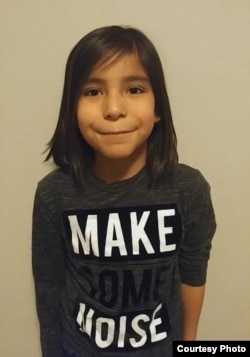Mylon McArthur is eight years old. He comes from the first people to live in Canada. His family belongs to the Pheasant Rump Nakota Nation in the province of Saskatchewan. Mylon is the only native child in his class at school. Until recently, he wore his hair in a traditional style for native boys and men: long.
But some other children at school bullied him about his long braids.
His mother was worried. She saw that Mylon came home from school crying. She did not want him to become depressed, or even suicidal. She knew the number of native children who have killed themselves has been increasing.
So she asked Mylon to cut his hair. But before he did, he made a video. In it, he spoke against the bullies and told teachers and parents to explain why long hair is important.
The video went viral. In other words, many people watched it – more than 1 million. Mylon’s video is the latest part in a long history about native people and hair.
What can hair mean?
The meaning of hair is different across tribes. And traditional native hairstyles are also different. For example, hair can be loose, braided, or worn in a knot.
Many native groups see hair as a source of strength and power. But government officials in the U.S. and Canada have historically seen native people’s hair differently.
L.G. Moses is a professor at Oklahoma State University. He says that government officials in the 1800s tried to force native people to be more like the European settlers. One way the officials did that was by making native children and adults cut their hair. Long hair, they believed, showed that a person was wild – not civilized.
The practice has not ended. Even today, many public school systems, prisons, and some workplaces require native people to wear their hair short.
Turning to social media
Native people have resisted pressure to cut their hair in many ways, including taking legal action. Recently, they are also – like Mylon – using social media.
In 2016, a member of the Cree group from Thunderchild First Nation in Saskatchewan, Canada created a Facebook page to address long hair in native people. Michael Linklater was harassed as a child about wearing his hair in braids. His sons were also bullied about their hair. So Linklater created a group called Boys With Braids.
The group is now a social movement. It has spread across Canada and into the United States.
In the U.S. state of South Dakota, some boys attend weekly Boys With Braids meetings and events. They learn to ride horses, cook, and even hunt buffalo. The activities aim to make them feel proud not just of their hair, but of all the traditions of their culture.
Mylon McArthur, who made the anti-bullying video, has not yet been able to go to a Boys With Braids event. But he hopes to soon.
Mylon also says that, since he made the video, two things have changed. The other children stopped bullying him. And he decided to grow his hair long again.
He says, “I can’t wait!”
I’m Kelly Jean Kelly.
Cecily Hilleary reported this story for VOA News. Kelly Jean Kelly adapted the report for VOA Learning English. Hai Do was the editor.
______________________________________________________________
Words in This Story
province - n. any one of the large parts that some countries are divided into
braids - n. an arrangement of hair made by weaving three sections together
suicidal - adj. wanting to kill yourself
bully - n. someone who frightens, hurts, or threatens smaller or weaker people
knot - n. a way of arranging long hair by twisting it into a round shape at the sides or back of the head
harass - v. to annoy or bother someone in a constant or repeated way








